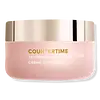What's inside
What's inside
 Key Ingredients
Key Ingredients

 Benefits
Benefits

 Concerns
Concerns

 Ingredients Side-by-side
Ingredients Side-by-side

Water
Skin ConditioningPentylene Glycol
Skin ConditioningGlycerin
HumectantMaris Sal
Skin ConditioningSqualane
EmollientBakuchiol
AntimicrobialRhododendron Ferrugineum Extract
MaskingN-Prolyl Palmitoyl Tripeptide-56 Acetate
Skin ConditioningBetaine
HumectantSodium Hyaluronate
HumectantEctoin
Skin ConditioningPhytic Acid
Arginine
MaskingLecithin
EmollientPanthenol
Skin ConditioningPullulan
Silica
AbrasivePotassium Sorbate
PreservativeHydroxyethylcellulose
Emulsion StabilisingSclerotium Gum
Emulsion StabilisingCaprylyl Glycol
EmollientXanthan Gum
EmulsifyingWater, Pentylene Glycol, Glycerin, Maris Sal, Squalane, Bakuchiol, Rhododendron Ferrugineum Extract, N-Prolyl Palmitoyl Tripeptide-56 Acetate, Betaine, Sodium Hyaluronate, Ectoin, Phytic Acid, Arginine, Lecithin, Panthenol, Pullulan, Silica, Potassium Sorbate, Hydroxyethylcellulose, Sclerotium Gum, Caprylyl Glycol, Xanthan Gum
Water
Skin ConditioningButyrospermum Parkii Butter
Skin ConditioningIsononyl Isononanoate
EmollientTheobroma Cacao Seed Butter
EmollientGlycerin
HumectantCetyl Alcohol
EmollientCoconut Alkanes
EmollientCetyl Phosphate
EmulsifyingBakuchiol
AntimicrobialRhododendron Ferrugineum Extract
MaskingTetrapeptide-21
Skin ConditioningBiosaccharide Gum-1
HumectantPhytic Acid
Tocopherol
AntioxidantArginine
MaskingHelianthus Annuus Seed Oil
EmollientPotassium Sorbate
PreservativeCoco-Caprylate/Caprate
EmollientEthylhexylglycerin
Skin ConditioningButylene Glycol
HumectantXanthan Gum
EmulsifyingDisodium Phosphate
BufferingPhenoxyethanol
PreservativeWater, Butyrospermum Parkii Butter, Isononyl Isononanoate, Theobroma Cacao Seed Butter, Glycerin, Cetyl Alcohol, Coconut Alkanes, Cetyl Phosphate, Bakuchiol, Rhododendron Ferrugineum Extract, Tetrapeptide-21, Biosaccharide Gum-1, Phytic Acid, Tocopherol, Arginine, Helianthus Annuus Seed Oil, Potassium Sorbate, Coco-Caprylate/Caprate, Ethylhexylglycerin, Butylene Glycol, Xanthan Gum, Disodium Phosphate, Phenoxyethanol
Ingredients Explained
These ingredients are found in both products.
Ingredients higher up in an ingredient list are typically present in a larger amount.
Arginine is an amino acid that is important for human development. Your body uses is it to produce hair keratin and skin collagen.
As a cosmetic ingredient, Arginine has antioxidant properties and can also help repair damaged skin. This ingredient is derived either synthetically or from animals.
Arginine isn't fungal acne safe when used in the presence of other lipids (fats, fatty acids, oils, esters, etc). Oils and fats occur naturally within the skin, so take caution when using Arginine if you're prone to fungal acne.
Learn more about ArginineBakuchiol is a plant-derived antioxidant (it's vegan!). It is often called the replacement for retinol although it is not part of the same family.
It has similar effects as retinol: skin smoothing, reducing discoloration, and preventing wrinkles. It does not cause as much irritation as traditional retinoids.
Bakuchiol works by breaking down free radicals and stimulating collagen production in skin.
Combining bakuchiol with retinol will not have adverse side effects. Studies show using them will just boost the benefits. Bakuchiol is also found to help stabilize retinol.
While bakuchiol does not make the skin more sun sensitive, we recommend wearing SPF on a daily basis.
Read more about traditional retinol
Learn more about BakuchiolGlycerin is already naturally found in your skin. It helps moisturize and protect your skin.
A study from 2016 found glycerin to be more effective as a humectant than AHAs and hyaluronic acid.
As a humectant, it helps the skin stay hydrated by pulling moisture to your skin. The low molecular weight of glycerin allows it to pull moisture into the deeper layers of your skin.
Hydrated skin improves your skin barrier; Your skin barrier helps protect against irritants and bacteria.
Glycerin has also been found to have antimicrobial and antiviral properties. Due to these properties, glycerin is often used in wound and burn treatments.
In cosmetics, glycerin is usually derived from plants such as soybean or palm. However, it can also be sourced from animals, such as tallow or animal fat.
This ingredient is organic, colorless, odorless, and non-toxic.
Glycerin is the name for this ingredient in American English. British English uses Glycerol/Glycerine.
Learn more about GlycerinPhytic Acid is a gentle AHA and antioxidant. AHAs are chemical exfoliants that help remove dead skin cells. Phytic Acid has a slight and mild exfoliating effect.
The chemical makeup makes it classified as an AHA, much like lactic acid.
In some cases, it is a chelating agent. Chelating agents help prevent metals from binding to water, helping to stabilize the ingredients in a product.
An interesting fact about phytic acid is that it is considered an antinutrient. People do not have the enzyme needed to properly breakdown and digest phytic acid. When ingested, phytic acid binds to minerals and prevents them from being absorbed.
Read more about some other popular AHA's here:
Learn more about Phytic AcidPotassium Sorbate is a preservative used to prevent yeast and mold in products. It is commonly found in both cosmetic and food products.
This ingredient comes from potassium salt derived from sorbic acid. Sorbic acid is a natural antibiotic and effective against fungus.
Both potassium sorbate and sorbic acid can be found in baked goods, cheeses, dried meats, dried fruit, ice cream, pickles, wine, yogurt, and more.
You'll often find this ingredient used with other preservatives.
Learn more about Potassium SorbateWe don't have a description for Rhododendron Ferrugineum Extract yet.
Water. It's the most common cosmetic ingredient of all. You'll usually see it at the top of ingredient lists, meaning that it makes up the largest part of the product.
So why is it so popular? Water most often acts as a solvent - this means that it helps dissolve other ingredients into the formulation.
You'll also recognize water as that liquid we all need to stay alive. If you see this, drink a glass of water. Stay hydrated!
Learn more about WaterXanthan gum is used as a stabilizer and thickener within cosmetic products. It helps give products a sticky, thick feeling - preventing them from being too runny.
On the technical side of things, xanthan gum is a polysaccharide - a combination consisting of multiple sugar molecules bonded together.
Xanthan gum is a pretty common and great ingredient. It is a natural, non-toxic, non-irritating ingredient that is also commonly used in food products.
Learn more about Xanthan Gum